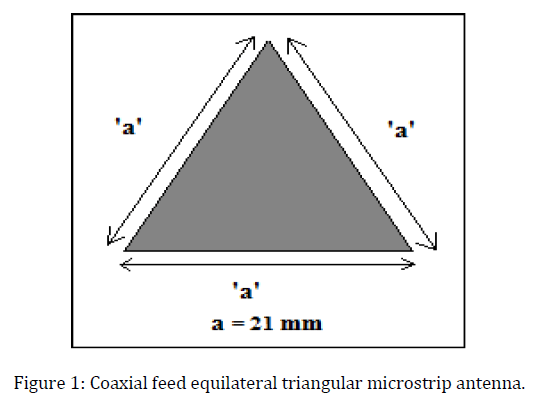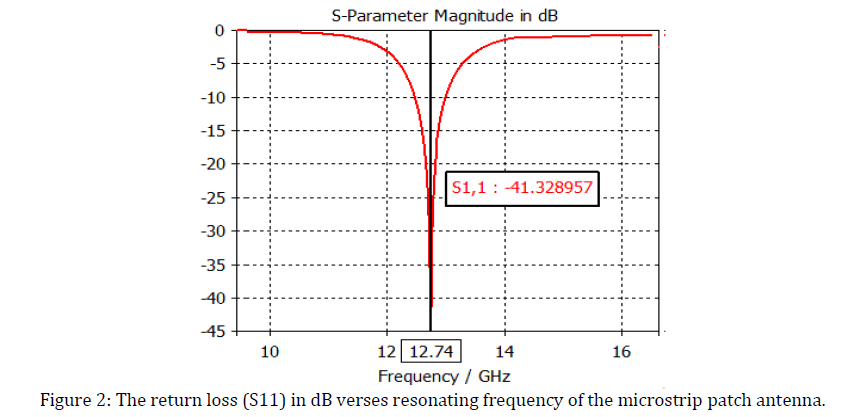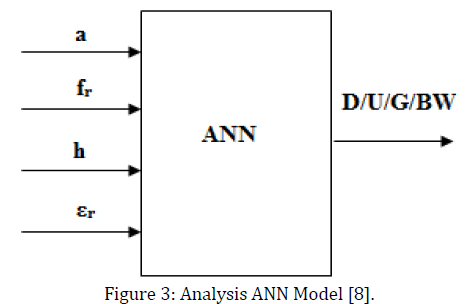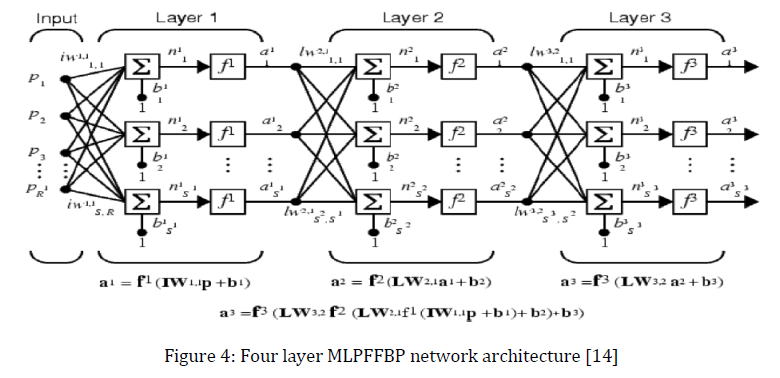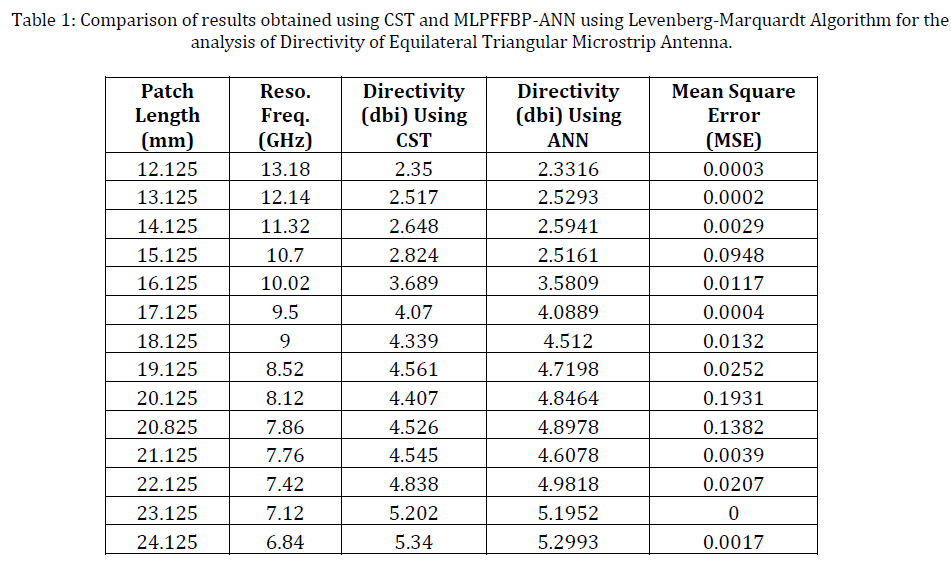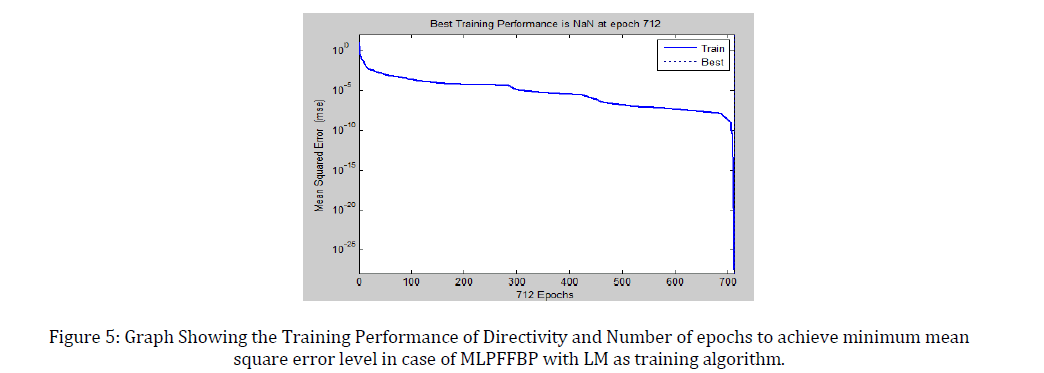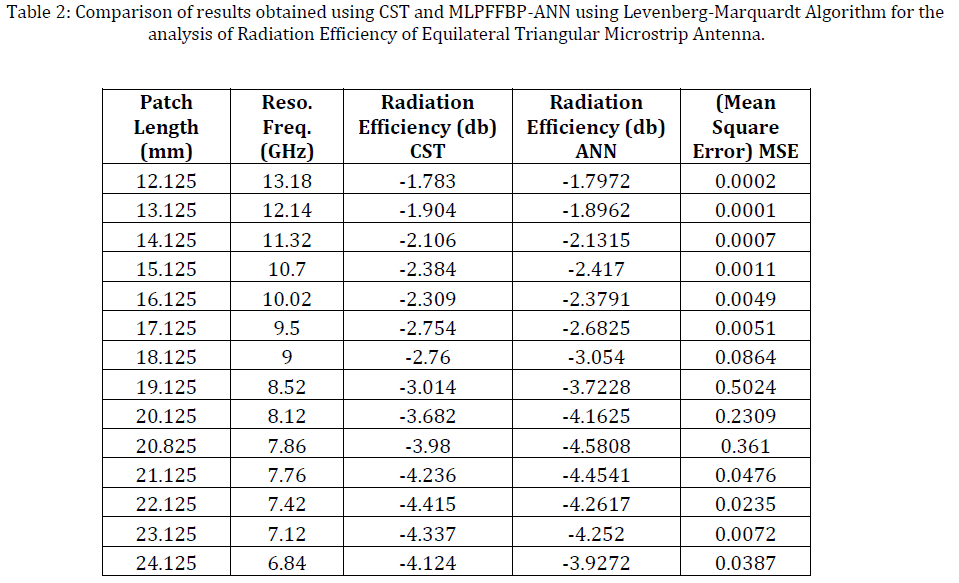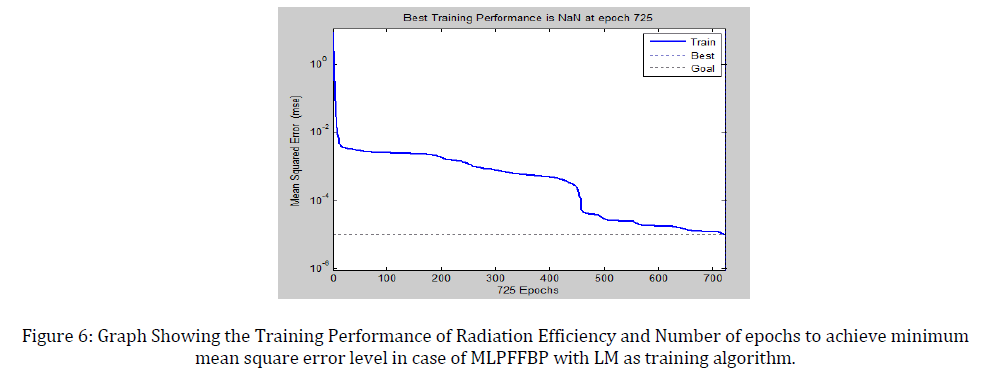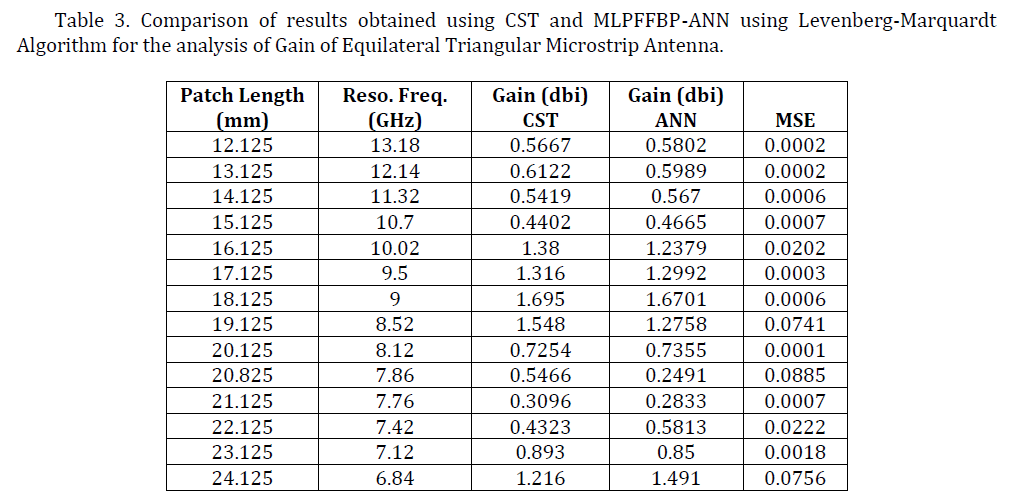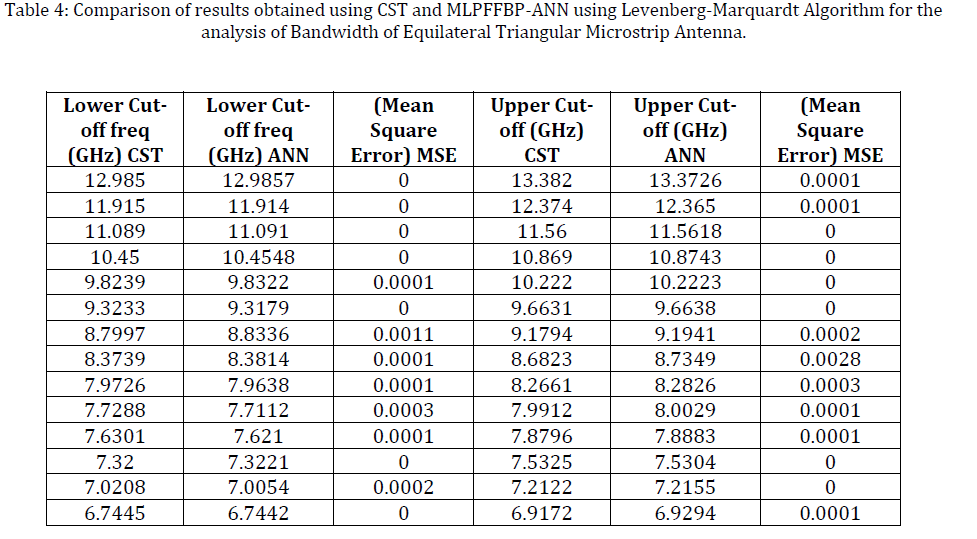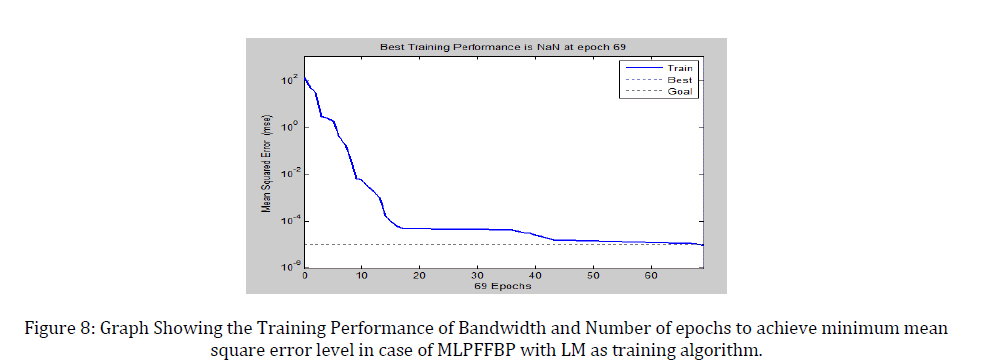Research Article Open Access
Analysis of Different Performance Parameters of Equilateral Triangular Microstrip Patch Antenna using Artificial Neural Network
Abhishek Tripathi*, Vandana Vikas Thakare, and P. K. SinghalDepartment of electronics, Madhav Institute of Technology and Science Gwalior MP, India
- *Corresponding Author:
- Abhishek Tripathi
Department of electronics, Madhav Institute of Technology and Science Gwalior MP, India
E-mail: abhishek5191@gmail.com
Visit for more related articles at International Journal of Advance Innovations, Thoughts & Ideas
Abstract
This paper presents the use of artificial neural network for the estimation of different performance parameters (i.e. Directivity, Radiation Efficiency, Gain and Bandwidth) of a coaxial feed equilateral triangular microstrip patch antenna. Levenberg-Marquardt training algorithms of MLPFFBP-ANN (Multilayer Perceptron feed forward back propagation Artificial Neural Network) has been used to implement the neural network models. The simulated values for training and testing the neural networks are obtained by analysing the equilateral triangular microstrip patch antenna using CST Microwave Studio Software. The results obtained using ANNs are compared with the simulation findings and found quite satisfactory and also it is found that neuro models are not converges using one hidden layer for the calculated training data so more than one one hidden layers are used for training the neural network models.
Keywords
Artificial Neural Networks (ANN), Bandwidth, Directivity, Gain, Microstrip Antenna, Multilayer Feed Forward Networks and Radiation Efficiency.
Introduction
Microstrip antennas due to their many attractive features have drawn attention of industries for an ultimate solution for wireless communication. The existing era of wireless communication has led to the design of an efficient, wide band, low cost and small volume antennas which can readily be incorporated into a broad spectrum of systems [1,2]. This needs very accurate calculation of various design parameters of microstrip patch antennas. Apart from Resonant Frequency and Patch Dimensions other important antenna parameters are Directivity, Gain, Radiation Efficiency and Bandwidth. These parameters play the vital role in deciding the utility of a microstrip antenna.
ANN application to the field of microwaves is very recent. A number of papers [3-11] indicate how ANNs can be used efficiently in analysing and synthesizing various microwave circuits. Neuro models are computationally much more efficient than EM models once they are trained with reliable learning data obtained from a “fine” model by either EM simulation or measurement [3,4,5,6]. The Neuro models can be used for efficient and accurate optimization and design within the range of training.
Sufficient amount of work has been done using ANN in determining the resonant frequencies and patch dimensions of circular and rectangular microstrip patch antennas [3-7], but other antenna performance parameters are yet not analysed. In this paper, an attempt has been made to exploit the capability of artificial neural networks to calculate the different performance parameters i.e Directivity, Gain, Radiation Efficiency and Bandwidth of coaxial feed equilateral triangular microstrip patch antenna using two hidden layers for the specified range of patch dimension (10mm-25mm), using Levenberg-Marquardt training algorithm of MLPFFBP-ANN.
Design and Data Generation
The equilateral triangular microstrip patch antenna is made up of side length ‘a’ mm over a ground plane with substrate thickness ‘h’ mm having dielectric constant ‘εr’. There are numerous substrates that can be used for the design of microstrip antennas and their dielectric constants are usually in the range of 2.2 ≤ εr ≤ 12. Thin substrates with higher dielectric constants are desirable for microwave circuitry because they require tightly bound fields to minimize undesired radiation and coupling, and lead to smaller element [3]. The software used to model and simulate the proposed microstrip patch antenna is CST (Computer Simulation Technology) Microwave Studio Software [12].
As an example a coaxial feed equilateral triangular microstrip antenna of side length a=21mm is simulated using CST Software which is resonating at 12.74 GHz frequency. The dielectric substrate FR4 (Lossy) is used with dielectric constant (εr) = 4.3, and substrate thickness (h) =1.6 mm on a ground plane.
Figure 1 shows the geometry of coaxial feed equilateral triangular microstrip antenna. By varying length of this geometry the training and test data for the range of (10mm-25mm) has been generated using MLPFFBP. Figure 2 shows the return loss (S11) vs. frequency curve for the proposed antenna.
ANN Model for Analysis of Performance Parameters of Microstrip Patch Antenna
The artificial neural network model has been developed for triangular microstrip patch antenna as shown in Figure 3. The feed forward network has been utilized to analyze the Directivity (D)/ Radiation Efficiency (U)/ Gain (G)/ Bandwidth (BW) of the patch for the given value of length of the patch ‘a’ (mm), resonant frequency of the patch ‘fr’ (GHz),substrate dielectric constant ‘εr’ and substrate height ‘h’ without doing complex calculations using empirical formulas.
Figure 3: Analysis ANN Model [8].
Network Architecture for Analysis of Different Performance Parameters of Microstrip Antenna
For the present work the four layer multilayer perceptron feed forward back propagation neural network (MLPFFBP) [13,14] is used with Levenberg-Marquardt training algorithms as shown in Figure 4. They are supervised networks, and also they required a desired response to be trained. With one or two hidden layers they can approximate virtually any input output map. The weights of the networks are usually computed by training the network using the back propagation algorithms [15].
Figure 4: Four layer MLPFFBP network architecture [14]
In order to evaluate the performance of proposed MLPFFBP-ANN based models for the design of equilateral triangular microstrip antenna, simulation results are obtained using CST Microwave Studio Software and generated 61 input-output training patterns and 14 inputs-output test patterns to validate the model. The network has been trained for a specified range (10mm - 25mm).
During the training process the neural network automatically adjusts its weights and threshold values such that the error between predicted and sampled outputs is minimized [16]. The adjustments are computed by the back propagation algorithm. The error goal is 1e-5 and learning rate is 0.1. The transfer function preferred is tansig and purelin in the architecture. First the proposed model has been trained using one hidden layer but it is not converges for the same in 1000 no of epochs. Then model is trained using two hidden layer.
A. Directivity
Directivity (D) measures the power density, the antenna radiates in the direction of its strongest emission, versus the power density radiated by an ideal isotropic radiator (which emits uniformly in all directions) radiating the same total power [1].
In the model, developed for the analysis of Directivity there are 60 neurons in the first hidden layer, 5 neurons in the second hidden layer and one output neuron. The training completes in 712 epochs and the training time is 2.21 min to achieve minimum Mean Square Error (MSE).
In table 1 Directivity obtained by using CST Software and L-M Algorithm for different test patterns are compared and the Mean Square Error has been calculated.
Figure 5 shows the training performance of the developed neural model for proposed antenna using L-M training Algorithm. Model is trained in 712 epochs and the training time was 2.21 min.
B. Radiation Efficiency
Radiation Efficiency (U) is a measure of the efficiency with which a radio antenna converts the radiofrequency power accepted at its terminals into radiated power [1].
Another model has been developed for the analysis of radiation efficiency keeping the training algorithm, error goal and learning rate same as Levenberg – Marquardt, 1e-5 and 0.1 respectively. Again for training the model two hidden layers have been used since it is not converges using one hidden layer. No of neurons in the first hidden layer are 60; in the second hidden layer is 5 and one output neuron. The training completes in 725 epochs and the training time is 35 sec. to achieve minimum Mean Square Error (MSE).
In table 2 Radiation Efficiency is obtained by using CST Software and L-M Algorithm for different test patterns are compared and the Mean Square Error has been calculated. Figure 6 shows the training performance of the developed neural model for proposed antenna using L-M training Algorithm. Model is trained in 725 epochs and the training time was 35 sec.
C. Gain
Gain (G) is a measure of the ability of a circuit to increase the power or amplitude of a signal from the input to the output, by adding energy to the signal converted from some power supply [1].
For the analysis of Gain (G) the developed model has been trained using L-M Algorithm keeping error goal and learning rate as 1e-5 and 0.1 respectively. Also 60, 10 and 1 are the no of neurons used in the first hidden layer, second hidden layer and in the output layer. Proposed model has been trained in 781 epochs and the training time was 1.37 min.
In table 3 Gain obtained by using CST Software and L-M Algorithm for different test patterns are compared and the Mean Square Error has been calculated. Figure 7 shows the training performance of the developed neural model for proposed antenna using L-M training Algorithm. Model is trained in 781 epochs and the training time was 1.37 min.
D. Bandwidth
Bandwidth (BW) describes the range of frequencies over which the antenna can properly radiate or receive energy [1].
In bandwidth analysis the neural network model has been trained simultaneously for both LCF and UCF. For training the proposed model two hidden layers have been used and the no of neurons used in the first hidden layer are 60, in the second hidden layer are 10 and one neuron is in the output layer. The model has been trained in 69 epochs and the training time was 9 sec.
In table 4 Lower Cut-off frequency as well as Upper Cut-off frequency obtained by using CST Software and LM Algorithm for different test patterns is compared and the Mean Square Error has been calculated. Figure 8 shows the training performance of the developed neural model for proposed antenna using L-M training Algorithm. Model is trained in 69 epochs and the training time was 9 sec.
Experimental Description
It has been established from Table I, II, III and IV that the Levenberg-Marquardt algorithm is the optimal model to achieve desirable values of speed of convergence. It has been observed that in the analysis of different antenna parameters i.e. Directivity (D), Radiation Efficiency (U), Gain (G) and Bandwidth (BW), MSE level has been reduced to a low value of 1e-5 for three layers MLPFFBP with Levenberg-Marquaradt (LM) training algorithm and tansig as a transfer function. Achievement of such a low value of performance goal (MSE) indicates that trained ANN model is an accurate model for analysing the performance parameters of coaxial feed equilateral traingular microstrip patch antenna. It is observed that tansig is most suitable transfer function for the present work.
Conclusion
In this paper, the different parameters of equilateral triangular microstrip patch antenna using MLPFFBP- ANN have been analysed. The results obtained with the present technique are closer to the experimental results generated by simulating a large no of triangular antennas using CST software on the FR4 (Lossy) substrate. The paper concludes that results obtained using present ANN techniques are quite satisfactory and followed the experimental trend.
References
- Balanis, C. A., Antenna Theory, John Wiley & Sons, Inc., 1997.
- P. K. Singhal and L. Srivastava, “On the investigations of a wide band proximity fed bow tie shaped microstrip antenna”, Journal of Microwave and Optoelectronics, Vol. 3, pp. 87-98, April 2004.
- Thakare V. V., Singhal P. K., “Bandwidth Analysis by introducing slots in microstrip antenna design using ANN”, Progress In Electromagnetic Research M., Vol. 9, 107 – 122, 2009.
- Thakare, V. V., Jadon, Shalendra Singh, Kumari, Ritesh, “Analysis of Circular Microstrip Patch Antenna Using Radial Basis Artificial Neural Network”, IJECSE, ISSN- 2277-1956
- Thakare, V. V., Singhal, P. K., “Neural Network based CAD model for the design of rectangular patch antennas”, Journal of Engineering and Technology Research Vol.2 (7), pp.126-129, July 2010.
- Vandana Vikas Thakare, Pramod Singhal, “Artificial Intelligence in the estimation of patch dimensions of Rectangular Microstrip Antennas” Circuits and Systems, Oct. 2011, Vol. 2, pp.330-337.
- Khan Taimoor, De Asok, “Computation of Different Parameters of Triangular Patch Microstrip Antennas Using a Common Neural Model”, International Journal of Microwave and Optical Technology, Vol. 5, No. 4, pp. 219-224 July 2010.
- Zhang, Q. J. and K. C. Gupta, Neural Networks for RF and Microwave Design, Artech House Publishers, 2000.
- Qi-Jun Zhang, Senior Member, IEEE, Kuldip C. Gupta, Fellow, IEEE, and Vijay K. Devabhaktuni, Student Member, IEEE “Artificial Neural Networks for RF and Microwave Design—From Theory to Practice”, IEEE Transaction on Microwave Theory and Techniques, Vol. 51, No. 4, April 2003.
- Lukasz Sorokosz, Wlodzimierz Zieniutycz, “Artificial Neural Networks in Microwave Components and Circuit Modelling”, Przeglad Elektrotechniczny (Electrical Review), ISSN 0033-2097, R. 88 NR 6/2012.
- M.Naser-Moghaddasi, Pouya Derakhshan Barjoei , Alireza Naghsh, “A Heuristic Artificial Neural Network for Analyzing and synthesizing Rectangular Microstrip Antenna”, International Journal of Computer Science and Network Security, Vol. 7, No.12, pp. 278-281, Dec 2007.
- CST (Computer Simulation Technology) Microwave Studio Suit Software 2010.
- Haykin, S., Neural Networks, 2nd edition, pHI, 2003.
- Hassoun, M. H., Fundamentals of Artificial Neural Networks, Chapter 8, New Delhi, Prentice Hall of India, 1999.
- S. Rajasekaran, G. A. Vijayalakshmi Pai, “Neural Networks, Fuzzy Logic, and Genetic Algorithms: Synthesis and Application”, Prentice Hall of India Limited, New Delhi, 2006.
- MATLAB Software, version 7.8.0, user manual.
- Rudra Pratap, “Getting started with MATLAB 7”, Oxford, 2005.
Relevant Topics
- Advance Techniques in cancer treatments
- Advanced Techniques in Rehabilitation
- Artificial Intelligence
- Blockchain Technology
- Diabetes care
- Digital Transformation
- Innovations & Tends in Pharma
- Innovations in Diagnosis & Treatment
- Innovations in Immunology
- Innovations in Neuroscience
- Innovations in ophthalmology
- Life Science and Brain research
- Machine Learning
- New inventions & Patents
- Quantum Computing
Recommended Journals
Article Tools
Article Usage
- Total views: 15755
- [From(publication date):
May-2013 - Apr 02, 2025] - Breakdown by view type
- HTML page views : 11055
- PDF downloads : 4700

